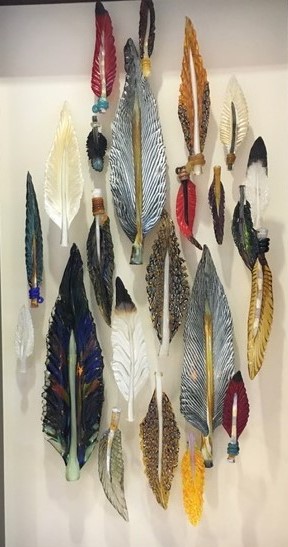
The House NEVER Loses
The most fun about writing a novel isn’t writing it but researching it. Sadly, right now it’s not possible to just jump in a car and dash off to see, hear, touch, smell, and if it’s a restaurant, taste, a place you’re writing about. Everything’s closed. Unless you happen to be writing about a casino. On Native American land. Because a federally recognized tribe has the right to regulate activities on its land independently of state control. Bingo!
And since the tribes don’t have to pander to Republican politics, they’re free to follow scientific guidelines for Covid. Temperature checks at the door, enforced social distancing everywhere and any self-obsessed cretin who refuses to wear a mask will find himself escorted off the reservation by large, intimidating Native security guards. Wearing masks. Nirvana.
Luckily, my book-in-progress (a third Blue McCarron mystery) has a scene in a casino owned by the Viejas Band of Kumeyaay Indians, so yesterday we drove up there so I could get the details right. It’s just one scene, a flashy pop concert, but I’ve never been to a concert or anything else at a casino and wanted to get the descriptive fine points. You know, like the walls, the lighting, the carpet? And I could not make this carpet up!

The Carpet
Walking on it, Blue will be forced to think of neural pathways invaded by a dark cloud of tiny flying saucers or fried eggs with blue yolks, a thought with no connection whatever to the story but that carpet is too interesting to leave out.

Glass Feathers
As are the glass feathers framed in the lobby. More pointless interior monologue about fragile, shattered feathers as a metaphor for something? Sure. But the most interesting aspect of this foray happened in a conversation with a drop-dead gorgeous descendant of the indigenous Puerto Rican Taino that provided enough information for 2 or 3 other novels. This is a problem with research. I got the carpet and feathers but also a wealth of information I wasn’t looking for!
At first Jasmene and I discussed her adult daughter’s seeming addiction to Q-Anon. The daughter has a master’s degree, shattering my assumption that educated folk automatically dismiss reports of satanic democrats kidnapping, raping and dismembering children as the production of some sick creep who’s paid handsomely to poison the minds of the not-too-bright. But this daughter is a smart, educated woman with a smart, educated mother, and she’s still terrified to take her small children out in public alone. She’s convinced that Satanist democrats will steal, defile and then slaughter them for salable organs. Jasmene’s rational arguments have no effect on her daughter, and I kept thinking this would make an interesting novel.
But then she told me about a Native activist group, No More Stolen Sisters, with which she’s involved. In Canada the sexual abuse and slaughter of First Nations women is recognized as an epidemic. In the U.S. the same epidemic quietly kills Native women and children who live anywhere near oil industry “man camps,” large tracts of rural temporary or permanent modular structures built to house the thousands of men who construct and maintain more than 190,000 miles of oil pipelines crossing the country. The carnage is particularly ghastly in remote areas of Montana and North and South Dakota where oil money rules, law enforcement jurisdictions are vague and investigations take so long that bodies decompose and vanish long before they can be found. It’s Ciudad Juárez all over again.

Activist Native women fighting to end this slaughter wear a red, painted hand over their mouths, symbol of both the official silence surrounding their missing numbers and their refusal to remain silent.
So a lighthearted trip to photograph a carpet, just something interesting to do during a pandemic characterized of necessity by boredom, changed the story I thought I was writing in a matter of minutes. Satanist democrats aren’t raping and killing children; that’s just sick QAnon propaganda. But Native women and children are being raped and killed. San Diego isn’t in North Dakota and the local Kumeyaay are running luxury casinos, not barely surviving in pitiless wastelands and subject to vicious exploitation by oil workers. But not all of them.
Across an artificial “Mexican” border thrown down by various warring European invaders, descendants of the same Kumeyaay ancestors struggle to survive in nearly inaccessible communities surrounding Tijuana and Tecate. With little water and acorns as a principal resource, most migrate to the nearby cities where they can find sporadic manual labor jobs. Illiterate and ill-equipped for success in a hi-tech 21st century, Kumeyaay women and girls in Mexico are easy prey for human traffickers engaged in the thriving border flesh industry.
That border is only 30 miles from my front door. Now all I need is a title for the book. It has to include the word, “Blue” and suggest some connection to Mexico or Native Americans or deserts. Suggestions welcome!
